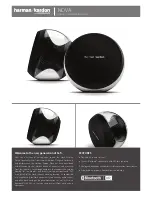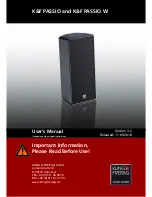
through continued use in arduous, real-life
conditions. The eight-hour EIA Loudspeaker
Power Rating Full Range (ANSI/EIA RS-
426-A 1980) uses a noise spectrum which
mimics typical music and tests the thermal and
mechanical capabilities of the components.
Electra-Voice will support relevant additional
standards as and when they become avail-
able. Extreme, in-house power tests, which
push the performance boundaries of the woof-
ers, are also performed and passed to ensure
years of trouble-free service.
Specifically, the TL880P passes ANSI/EIA
RS-426-A 1980 with the following values:
=
4.80 ohms (1.15 x
P
E(MAX) =
1,200 watts
Test voltage = 75.9 volts rms,
15 1.8 volts peak
The “peak” power-handling capacity of a
woofer is determined by the peak test volt-
age amount. For the TL880P, a 151.8-volt
peak test voltage translates into 4,800-watts
short-term peak power-handling capacity.
This is the equivalent of four times the “av-
erage” power-handling capacity, and is a
peak that can be sustained for only a few
milliseconds. However, this sort of short-
duration peak is very typical in speech and
music. Provided the amplifier can reproduce
the signal accurately, without clipping, the
woofer will also perform accurately and re-
liably, even at these levels.
Continuous program power is defined as 3 dB
above (double) the continuous sine-wave
power rating. The sine-wave power rating is
a two-hour test performed at the minimum
impedance of the system. It is included so
comparisons can be made with competitive
products.
Alternative Vent Tuning and
Equalization Options
The TL880P uses the on-board signal pro-
cessing of the P1250 amplifier to provide
the required equalization for operating in the
“step-down” mode. This equalization reaches
a maximum of 6 dB at 26 Hz and at 12 dB per
octave below this frequency (and at 24 dB per
octave below 15 Hz). Overall system re-
sponse is 3 dB down
at 23 Hz. (Achiev-
ing this same without equalization would
require twice the enclosure volume.) The
loudspeaker is shipped with its central port
cover in place to provide the appropriate,
25-Hz box tuning. This configuration must
be maintained for “as shipped” operation of
the TL88OP. The step-down mode maximizes
acoustic output ability at frequencies just
below 30 Hz (see Figure 1), appropriate for
the TL88OP’s primary application as a cin-
ema very-low-frequency subwoofer.
If it is not desired to use the TL88OP in the
step-down mode, eliminating the need for
boost-and-cut equalization, it is necessary to
remove the central port cover. This moves
box tuning up to 30 Hz and also moves the
system up to 30 Hz. See the P1250 Set-
tings section for proper amplifier settings in
the normal mode.
Subpassband Speaker Protection
The P1250 power amplifier provides 12-dB-
per-octave infrasonic protection of the
EVX-18OA’s below the P125O’s peak-boost
frequency of 26 Hz. Protection is increased
to 24 dB per octave below 15 Hz.
P1250 Settings
The TL880P is shipped with the P1250 rear-
panel processor settings set for step-down
mode. See Figure 6. The speakers are con-
nected to the central, bridged output. In the
event that the rear-panel settings are dis-
turbed, the proper settings are noted below.
The rear panel of the P1250 is easily acces-
sible through the access/vent opening in the
speaker enclosure side closest to the top of
the amplifier:
Step-Down Mode Settings (as shipped):
1.
Limiter Time Constant switch: Slow.
2. Processor switch: B6.
3. Pole Frequency switch: 26.
4. Bridged Mode switch: Bridged.
5. Hi-Low-Cut Filter switch: 15.
Normal Mode Settings:
1.
Limiter Time Constant switch: Slow.
2. Processor switch: Off.
3. Pole Frequency switch: N/A
4. Bridged Mode switch: Bridged.
5. Hi-Low-Cut Filter switch: 31 Hz.
Use in Multiples
Cone loudspeakers may be
stacked
for
greater acoustic output and a narrower
beamwidth. (It is assumed that all cones are
operating in unison or “in phase.“) This prin-
ciple is already employed in the dual-woofer
TL88OP, and is responsible for the higher
sensitivity and narrower vertical beamwidth
(with the system long axis vertical) relative
to similar single-woofer systems. In addi-
tion, two TL880P’s can be used side-by-side
and their combined performance will be dif-
ferent from that of a single TL880P in the
ways outlined below.
At relatively low frequencies, below about
150 Hz for typical TL series dimensions,
stacking produces additional acoustic out-
put without altering dispersion. When a
common signal is applied, a 6-dB increase
in maximum acoustic output occurs. The
cones “mutually couple” and act as one cone
with twice the area (therefore twice the effi-
ciency) and twice the power capacity. The
additional cone area provides 3 dB more
output and the additional power capacity
accounts for the remaining 3 dB.
Specifically, mutual coupling occurs at fre-
quencies whose wavelengths are longer that
one-quarter the center-to-center distance be-
tween the cones. The highest frequency at
which mutual coupling occurs is calculated
from the following equation:
3,000
D
MAX
where
(inches) is the distance between
the cones, and f (Hz) is the highest frequency
at which coupling occurs. When
is
greater than one-quarter wavelength, which
would occur if two TL880P’s were widely
spaced, or at frequencies much above f even
when closely spaced, the increase in acous-
tic output is limited to the 3-dB power-han-
dling increase.
Service
In the unlikely event the
requires ser-
vice, the woofer can be replaced or serviced
from the front and the amplifier can be re-
placed or serviced from the top. A service
data sheet is available from Electro-Voice.























